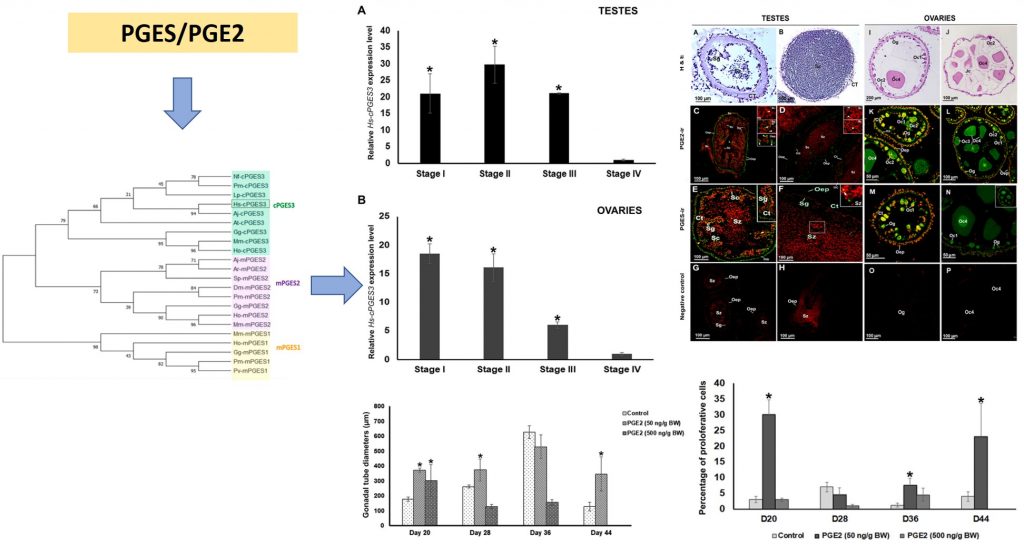
การศึกษาการออกฤทธิ์ และการแสดงออก ของ prostaglandin E2 ในปลิงทะเลขาว Holothuria scabra
Highlight:
ในการศึกษานี้ คณะผู้วิจัยได้ค้นพบและทำการศึกษาคุณลักษณะของ prostaglandin synthase (PGES) ในปลิงทะเลขาว H. scabra ชื่อว่า Hs-cPGES3 และได้ทำการศึกษาการแสดงออกของ Hs-cPGES3 mRNA expression levels พบว่า มีระดับสูงในอวัยวะสืบพันธุ์ระยะแรก (early stages) และค่อยๆลดลงในระยะสุดท้าย (late gonadal stages) กลุ่มที่ฉีดด้วย prostaglandin E2 (PGE2) กระตุ้นการพัฒนาของรังไข่ อัณฑะ และกระตุ้นการพัฒนาของเซลล์สืบพันธุ์ อย่างมีนัยสำคัญทางสถิติเมื่อเทียบกับกลุ่มควบคุม ดังนั้นผลการวิจัยที่นี้ได้รับองค์ความรู้พื้นฐานใหม่ที่สำคัญเกี่ยวกับบทบาทและการแสดงออกของ PGE2 และ PGES ในอวัยวะสืบพันธุ์ และอาจจะนำไปประยุกต์ใช้ในการช่วยเพิ่มการผลิตของปลิงทะเลขาวซึ่งเป็นสัตว์น้ำเศรษฐกิจที่สำคัญชนิดนี้ได้
ที่มาและความสำคัญ
The white sea cucumber, Holothuria scabra, is among the highest-priced economic marine species in the commercial fisheries of the tropical Indo-Pacific region, including Thailand (Hamel et al., 2001; Purcell et al., 2012). This animal has the high nutrient quality and richness in medicinal substances (Demeuldre and Eeckhaut, 2012). There is a high risk of overfishing this species which greatly affects the wild population. In the past few years, attempts have been made to produce this species by aquaculture. However, the breeding of H. scabra broodstocks in captivity is partially successful because their gonads fail to fully develop, and only a limited quantity of gametes can be obtained with a prolonged spawning period (Chiyamoon et al., 2020b; Nontunha et al., 2021). Therefore, the identification of some important hormonal factors, that regulate gonadal development and gametogenesis, is important and necessary for increasing the production of gametes for mass production of this sea cucumber species by aquaculture. However, important questions remain whether PGE2 plays a critical role in the reproduction of the sea cucumber H. scabra. Therefore, we characterized Hs-cPGES3, a key enzyme involved in PGE2 biosynthesis, and further examined the presence and distribution of PGES and PGE2 in the gonadal tissues. Functionally, we then investigated the roles of PGE2 in gonadal development and gametogenesis of H. scabra by using bioassays.
Abstract
Prostaglandin E2 (PGE2) plays important roles in several physiological processes, including reproduction of several marine invertebrate species. The aims of the present study were to characterize the putative prostaglandin E synthase (PGES), an enzyme that is involved in the PGE2 biosynthetic pathway, in the sea cucumber, H. scabra. We then examined the presence and distribution of PGES and PGE2 in gonadal tissues using RT-qPCR and immunohistochemistry, and further investigated the effects of PGE2 on gonadal development and germ cell proliferation by using functional assays. Transcriptomic data and molecular cloning analyses from gonadal tissues of H. scabra were performed, and these tissues were found to have the PGES in H. scabra, namely Hs-cPGES3. By using RT-qPCR, the Hs-cPGES3 mRNA expression levels were higher at the early stages than the late stages of the gonadal cycle. In addition, the presence of PGE2 and its corresponding enzyme, Hs-cPGES3, was detected in the gonads with the highest intensities appearing in gamete cytoplasm during the early stages than those at the late stages. Functionally, PGE2, at the doses of 50 and 500 ng/g BW, significantly promoted gonadal development, gonado-somatic index (GSI), gonadal tube diameters, and increased germ cell proliferation, compared with those of the control animals (P < 0.05). Taken together, our findings are the first to demonstrate the presence of PGE2 and its biosynthetic-associated enzymes in the gonadal tissues, and its effects on gonadal development and germ cell proliferation in this sea cucumber. The knowledge gained would improve understanding of PGE2 mechanism in controlling gonadal development, which could be useful in enhancing the production of seeds for aquaculture of H. scabra.
Keywords: Sea cucumber, Holothuria scabra, Prostaglandin E2, Prostaglandin synthase, Gonadal development, Aquaculture
Citation:
Nontunha N, Tinikul T, Chaiyamoon A, Vetkama W, Thongbuakaew T, Chaichotranunt S, Poomtong T, Sobhon P, Tinikul Y. (2022). The effects of prostaglandin E2 on gonadal development and germ cell proliferation, and its presence during the gonadal cycle in the sea cucumber, Holothuria scabra. Aquaculture 555C, 738201. https://doi.org/10.1016/j.aquaculture.2022.738201
RELATED SDGs:
14. LIFE BELOW WATER

ผู้ให้ข้อมูล: รองศาสตราจารย์ ดร.ยสวันต์ ตินิกุล
ชื่ออาจารย์ที่ทำวิจัย: รองศาสตราจารย์ ดร.ยสวันต์ ตินิกุล
ชื่อนักศึกษาที่ทำวิจัย: นางสาวนิตติญา นนทันหา นางสาววรินทิพย์ เวชกามา
แหล่งทุนวิจัย: Agricultural Research Development Agency, Thailand Research Fund (TRF), Thailand Science Research and Innovation and Mahidol University, Mahidol University (Fundamental Fund: Basic Research Fund, fiscal year 2022), and Faculty of Science, Mahidol University.
Tags: Aquaculture, Gonadal development, Holothuria scabra, Prostaglandin E2, Prostaglandin synthase, Sea cucumber
